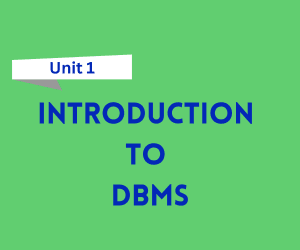
Free Download Introduction to DBMS Notes in pdf – Bca 4th Semester. High quality, well-structured and Standard Notes that are easy to remember.
Click on the Download Button 👇
Introduction to DBMS
A Database Management System (DBMS) is software that enables users to efficiently store, retrieve, and manage data in a structured format. It acts as an interface between the user and the database, ensuring organized data handling while providing tools for data manipulation, security, and access control. DBMS plays a crucial role in modern applications by enabling data-driven decision-making and supporting diverse use cases across industries like finance, healthcare, e-commerce, and more.
DBMS eliminates the need for manual data management, offering a centralized system to handle vast amounts of information. It ensures data consistency, reduces redundancy, and maintains integrity, making it indispensable in today’s data-centric world.
Key Points
Definition and Purpose:
- A DBMS is a software system that provides a framework to define, create, manage, and interact with databases.
- It facilitates data organization, retrieval, and manipulation while ensuring security and scalability.
Components of DBMS:
- Database: A collection of organized data.
- DBMS Software: The tool that manages and controls database operations.
- Users: Individuals or applications interacting with the database.
- Hardware: Physical devices for data storage and access.
Types of DBMS:
- Hierarchical DBMS: Data is organized in a tree-like structure.
- Network DBMS: Data is stored in a graph format with multiple parent-child relationships.
- Relational DBMS (RDBMS): Data is stored in tables (rows and columns), with SQL for querying.
- NoSQL DBMS: Used for unstructured or semi-structured data like documents or graphs.
Key Functions:
- Data Definition: Creating and modifying database schema.
- Data Manipulation: Inserting, updating, and deleting records.
- Data Retrieval: Efficient querying for specific information.
- Data Security: Protecting data against unauthorized access.
- Backup and Recovery: Safeguarding data from loss or corruption.
Features of DBMS
Data Abstraction:
- Hides complexities from users, providing a simple interface.
Data Consistency and Integrity:
- Ensures that data remains accurate and consistent.
Data Security:
- Implements authentication and authorization mechanisms.
Scalability:
- Manages increasing volumes of data and user queries.
Concurrency Control:
- Handles multiple users accessing the database simultaneously without conflicts.
Reduced Data Redundancy:
- Eliminates duplicate data by normalizing tables.
Query Processing:
- Provides powerful tools like SQL for efficient data retrieval and manipulation.
Backup and Recovery:
- Ensures data safety with regular backups and robust recovery processes.
FAQs
Q1: What is a DBMS?
A1: A Database Management System is software that facilitates the storage, retrieval, and management of data in an organized way.
Q2: How does a DBMS differ from a traditional file system?
A2: DBMS offers better data organization, reduced redundancy, improved security, and efficient querying compared to file systems.
Q3: What are examples of DBMS software?
A3: Popular DBMS software includes MySQL, Oracle Database, Microsoft SQL Server, PostgreSQL, and MongoDB.
Q4: What are the advantages of using a DBMS?
A4: Advantages include centralized control, data integrity, scalability, security, and support for complex queries.
Q5: What is relational DBMS (RDBMS)?
A5: RDBMS organizes data into tables and uses SQL for querying. Examples include MySQL and PostgreSQL.
Q6: What is the difference between DBMS and NoSQL?
A6: DBMS typically handles structured data in tables, while NoSQL is designed for unstructured or semi-structured data like JSON or graph formats.
Q7: Why is data normalization important in DBMS?
A7: Normalization reduces data redundancy, improves integrity, and optimizes database performance.
Q8: How does a DBMS handle data security?
A8: DBMS uses authentication, encryption, and access control mechanisms to protect data from unauthorized access.